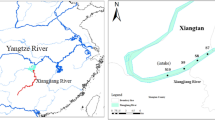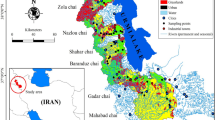Abstract
Surface water samples were collected from the sampling sites throughout the Xiangjiang River for investigating spatial variation, risk assessment and source identification of the trace elements. The results indicated that the mean concentrations of the elements were under the permissible limits as prescribed by guidelines except arsenic (As). Based on the health risk indexes, the primary contributor to the chronic risks was arsenic (As), which was suggested to be the most important pollutant leading to non-carcinogenic and carcinogenic concerns. Individuals, who depend on surface water from the Xiangjiang River for potable and domestic use, might be subjected to the integrated health risks for exposure to the mixed trace elements. Children were more sensitive to the risks than the adults, and the oral intake was the primary exposure pathway. Besides, multivariate statistical analyses revealed that arsenic (As), cadmium (Cd), lead (Pb), selenium (Se), and mercury (Hg) mainly derived from the chemical industrial wastewaters and the coal burning, and zinc (Zn) copper (Cu) and chromium (Cr) mainly originated from the natural erosion, the mineral exploitation activities, and the non-point agricultural sources. As a whole, the upstream of the Xiangjiang River was explained as the high polluted region relatively.





Similar content being viewed by others
References
Asante KA, Agusa T, Subramanian A, Ansa-Asare OD, Biney CA, Tanabe S (2007) Contamination status of arsenic and other trace elements in drinking water and residents from Tarkwa, a historic mining township in Ghana. Chemosphere 66:1513–1522
Avani G, Rao M (2007) Genotoxic effects in human lymphocytes exposed to arsenic and vitamin A. Toxicol in Vitro 21:626–631
Banerjee K, Senthilkumar B, Purvaja R, Ramesh R (2012) Sedimentation and trace metal distribution in selected locations of Sundarbans mangroves and Hooghly estuary, Northeast coast of India. Environ Geochem Health 34:27–42
Bhattacharya P, Welch AH, Stollenwerk KG, McLaughlin MJ, Bundschuh J, Panaullah G (2007) Arsenic in the environment: Biology and chemistry. Sci Total Environ 379:109–120
Carafa R et al (2011) Water toxicity assessment and spatial pollution patterns identification in a Mediterranean River Basin District. Tools for water management and risk analysis. Sci Total Environ 409:4269–4279
Chai L, Wang Z, Wang Y, Yang Z, Wang H, Wu X (2010) Ingestion risks of metals in groundwater based on TIN model and dose–response assessment—a case study in the Xiangjiang watershed, central-south China. Sci Total Environ 408:3118–3124
Chen SC, Liao CM (2006) Health risk assessment on human exposed to environmental polycyclic aromatic hydrocarbons pollution sources. Sci Total Environ 366:112–123
Chen Y, Wu F, Lu H, Yao C (2004) Analysis on the water quality changes in the Xiangjiang river from 1981 to 2000. Resour Environ Yangtze Basin 13:508–512 (in Chinese)
Cheung K, Poon B, Lan C, Wong M (2003) Assessment of metal and nutrient concentrations in river water and sediment collected from the cities in the Pearl River Delta, South China. Chemosphere 52:1431–1440
Chinese Ministry of Health (2007) Chinese State Standards (CSS) for Drinking Water Quality (GB5749-2006)
De Miguel E, Iribarren I, Chacon E, Ordonez A, Charlesworth S (2007) Risk-based evaluation of the exposure of children to trace elements in playgrounds in Madrid (Spain). Chemosphere 66:505–513
Giri S, Singh AK (2014) Risk assessment, statistical source identification and seasonal fluctuation of dissolved metals in the Subarnarekha River, India. J Hazard Mater 265:305–314
Goldhaber SB (2003) Trace element risk assessment: Essentiality vs. toxicity. Regul Toxicol Pharmacol 38:232–242
Ip CC, Li XD, Zhang G, Wai OW, Li YS (2007) Trace metal distribution in sediments of the Pearl River Estuary and the surrounding coastal area, South China. Environ Pollut 147:311–323. doi:10.1016/j.envpol.2006.06.028
Iqbal J, Shah MH, Akhter G (2013) Characterization, source apportionment and health risk assessment of trace metals in freshwater Rawal Lake, Pakistan. J Geochem Explor 125:94–101
Kim E, Little JC, Chiu N (2004) Estimating exposure to chemical contaminants in drinking water. Environ Sci Technol 38:1799–1806
Klavinš M, Briede A, Rodinov V, Kokorite I, Parele E, Klavina I (2000) Heavy metals in rivers of Latvia. Sci Total Environ 262:175–183
Lee CSL, Li XD, Zhang G, Li J, Ding AJ, Wang T (2007) Heavy metals and Pb isotopic composition of aerosols in urban and suburban areas of Hong Kong and Guangzhou, South China—Evidence of the long-range transport of air contaminants. Atmos Environ 41:432–447. doi:10.1016/j.atmosenv.2006.07.035
Li F et al (2014) Integrated source apportionment, screening risk assessment, and risk mapping of heavy metals in surface sediments: a case study of the Dongting Lake, Middle China. Hum Ecol Risk Assess Int J 20:1213–1230
Li F et al (2013) Spatial risk assessment and sources identification of heavy metals in surface sediments from the Dongting Lake, Middle China. J Geochem Explor 132:75–83
Li S, Zhang Q (2010) Risk assessment and seasonal variations of dissolved trace elements and heavy metals in the Upper Han River, China. J Hazard Mater 181:1051–1058
Liao CM, Chiang KC (2006) Probabilistic risk assessment for personal exposure to carcinogenic polycyclic aromatic hydrocarbons in Taiwanese temples. Chemosphere 63:1610–1619
Lim HS, Lee JS, Chon HT, Sager M (2008) Heavy metal contamination and health risk assessment in the vicinity of the abandoned Songcheon Au–Ag mine in Korea. J Geochem Explor 96:223–230
Lohani MB, Singh A, Rupainwar DC, Dhar DN (2008) Seasonal variations of heavy metal contamination in river Gomti of Lucknow city region. Environ Monit Assess 147:253–263. doi:10.1007/s10661-007-0117-1
Lu X, Wang L, Li LY, Lei K, Huang L, Kang D (2010) Multivariate statistical analysis of heavy metals in street dust of Baoji, NW China. J Hazard Mater 173:744–749
Mondal N, Singh V, Puranik S, Singh V (2010) Trace element concentration in groundwater of Pesarlanka Island, Krishna Delta, India. Environ Monit Assess 163:215–227
Oberholster P (2011) Using epilithic filamentous green algae communities as indicators of water quality in the headwaters of three South African river systems during high and medium flow periods Zooplankton and phytoplankton. pp. 107–122
Obiri S, Dodoo D, Okai-Sam F, Essumang D (2006) Cancer health risk assessment of exposure to arsenic by workers of AngloGold Ashanti–Obuasi Gold Mine. Bull Environ Contam Toxicol 76:195–201
Peng B et al (2011) Geochemistry of trace metals and Pb isotopes of sediments from the lowermost Xiangjiang River, Hunan Province (PR China): implications on sources of trace metals. Environ Earth Sci 64:1455–1473
Phan K et al (2013) Assessing mixed trace elements in groundwater and their health risk of residents living in the Mekong River basin of Cambodia. Environ Pollut 182:111–119
Phan K et al (2010) Health risk assessment of inorganic arsenic intake of Cambodia residents through groundwater drinking pathway. Water Res 44:5777–5788
Rodriguez-Proteau R, Grant RL (2005) Toxicity evaluation and human health risk assessment of surface and ground water contaminated by recycled hazardous waste materials. In: Water Pollution. Springer, pp 133–189
Saeedi M, Li LY, Salmanzadeh M (2012) Heavy metals and polycyclic aromatic hydrocarbons: Pollution and ecological risk assessment in street dust of Tehran. J Hazard Mater 227:9–17
Sun S, Hu G, Wang Y, Li C (2006) Water environmental health risk assessment of Xiangjiang River. J Saf Environ 6:12–15 (in Chinese)
USEPA (1989) Risk Assessment Guidance for Superfund Volume 1. Human Health Evaluation Manual (Part A). EPA/540/1-89/002 Office of Emergency and Remedial Response; U.S. Environmental Protection Agency, Washington, DC
USEPA (2004) Risk Assessment Guidance for Superfund Volume 1. Human Health Evaluation Manual (Part E, Supplemental Guidance for Dermal Risk Assessment). EPA/540/R/99/005 Office of Superfund Remediation and Technology Innovation; U.S. Environmental Protection Agency, Washington, DC
USEPA (2006) National recommended water quality criteria Office of Water, EPA-822-R-02-047, US Environmental Protection Agency
USEPA (2009) Drinking Water Standards and Health Advisories. EPA 822-R-09-011 Office of Water. U.S. Environmental Protection Agency, Washington
USEPA (2013) Risk-based concentration table. http://www.epa.gov/
Varol M (2011) Assessment of heavy metal contamination in sediments of the Tigris River (Turkey) using pollution indices and multivariate statistical techniques. J Hazard Mater 195:355–364
Varol M, Sen B (2012) Assessment of nutrient and heavy metal contamination in surface water and sediments of the upper Tigris River, Turkey. Catena 92:1–10
WHO (2008) Guidelines for drinking-water quality, recommendations incorporating 1st and 2nd Addenda, 13th edn. World Health Organization, Geneva
Winterbourn M, McDiffett W, Eppley S (2000) Aluminium and iron burdens of aquatic biota in New Zealand streams contaminated by acid mine drainage: effects of trophic level. Sci Total Environ 254:45–54
Wu B, Zhao D, Jia H, Zhang Y, Zhang X, Cheng S (2009) Preliminary risk assessment of trace metal pollution in surface water from Yangtze River in Nanjing Section, China. Bull Environ Contam Toxicol 82:405–409
Younger P, Banwart S, Hedin R (2006) Mine Water. Hydrology, Pollution, Remediation
Zhang GZ, Liu H, Jia DW (2010a) River basin management based on the mechanisms of water rights trading. Procedia Environ Sci 2:665–673. doi:10.1016/j.proenv.2010.10.075
Zhang Z, Tao F, Du J, Shi P, Yu D, Meng Y, Sun Y (2010b) Surface water quality and its control in a river with intensive human impacts—a case study of the Xiangjiang River, China. J Environ Manag 91:2483–2490
Zheng N, Wang Q, Liang Z, Zheng D (2008) Characterization of heavy metal concentrations in the sediments of three freshwater rivers in Huludao City, Northeast China. Environ Pollut 154:135–142
Zhu HN et al (2012) Ecological risk assessment of heavy metals in sediments of Xiawan Port based on modified potential ecological risk index. Trans Nonferrous Metals Soc China 22:1470–1477
Acknowledgments
The authors would like to thank financial support from the National Natural Science Foundation of China (Grant No. 41271332 and Grant No. 51478470) and the Science and Technology Planning Project of Hunan Province, China (Grant No. 2012SK2021).
Author information
Authors and Affiliations
Corresponding author
Additional information
Responsible editor: Philippe Garrigues
Rights and permissions
About this article
Cite this article
Zeng, X., Liu, Y., You, S. et al. Spatial distribution, health risk assessment and statistical source identification of the trace elements in surface water from the Xiangjiang River, China. Environ Sci Pollut Res 22, 9400–9412 (2015). https://doi.org/10.1007/s11356-014-4064-4
Received:
Accepted:
Published:
Issue Date:
DOI: https://doi.org/10.1007/s11356-014-4064-4




